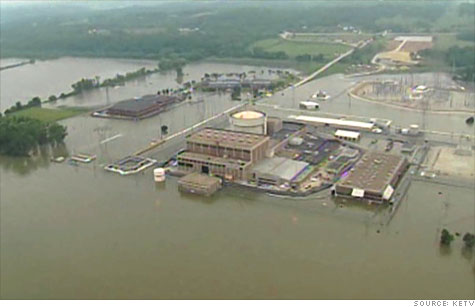Search News

Flood waters surround the Fort Calhoun nuclear power plant in Nebraska. Activists fear other U.S. plants are at risk.
NEW YORK (CNNMoney) -- Nebraska's flooded Fort Calhoun nuclear power plant is raising fears that other power plants in the United States are vulnerable to extreme weather events.
The Nebraska plant, located along the swollen Missouri River, is currently surrounded by about two feet of water. The facility, designed to withstand at least eight more feet of water, is reportedly dry inside, shut down and not thought to be in any immediate danger.
But activists say the situation highlights the precarious places many U.S. nuclear plants occupy. Nearly all of the nation's nuclear power plants are located next to some body of water -- many in tornado, earthquake or hurricane-prone parts of the country.
For example, New York's Indian Point plant has been called out as particularly risky, because it sits on an active fault line. And activists are concerned about Florida's Turkey Point facility, thanks to the large number of hurricanes that strike the area.
With the vast majority of the world's climate scientists predicting more extreme weather events in the years ahead as the planet warms, activists are calling for the at-risk plants to be shut or, at the very least, strongly reinforced.
"Each one has its own pathway to disaster," said Kevin Kamps, an activist at the watchdog group Beyond Nuclear. "Nuclear power is too risky to operate in a destabilized climate. We think it should be phased out."
A spokesman at the Nuclear Regulatory Commission, the federal agency charged with making sure the plants are safe, said plenty of protections are in place to avert disaster.
All plants in the United States have to be built to withstand the strongest weather-related event on record in that area, plus an additional safety margin, he said.
The Fort Calhoun facility can withstand flood waters reaching 1,014 feet above sea level, according to an NRC statement released on Sunday. The flood waters are currently at 1,006 feet above sea level, said the statement, and aren't expected to go higher than 1,008 feet.
The Missouri River is flooding as a result of a particularly snowy winter in Montana, Wyoming and the Dakotas, as well as heavy spring rains.
Kamps brought up the possibility of any one of the half-dozen dams upstream from the plant failing, calling that event a "nightmare" scenario that would push the water well past the 1,014-foot level the facility was built to withstand.
In that event, power to the plant from either its grid connection or back-up diesel generators could be lost, resulting in an inability to circulate water to keep either the reactor core or the spent fuel pool cool, said Kamps.
It was that scenario that led to the meltdown at Japan's Fukushima Daiichi nuclear power plant.
But NRC spokesman Scott Burnell said a Japanese-style meltdown is highly unlikely, even if the water breached the 1,014-foot mark.
For starters, the Nebraska plant has not been operating since April, when it was shut down for a planned refueling. That means the fuel in the core is cooler than normal, and would need less circulating water to prevent a meltdown.
The plant has also brought in emergency portable pumps and generators in case the existing ones fail due to an unexpected rise in the flood water level, he said.
As for the robustness of other plants nationwide, Burnell said new nuclear plants are built with the most current weather projections in mind, which would include any climate change-related events that might be more extreme.
As for older plants, he said "there's been nothing brought to the attention of the agency that would require existing plants to alter their designs in order to deal with severe weather." ![]()
| Overnight Avg Rate | Latest | Change | Last Week |
|---|---|---|---|
| 30 yr fixed | 3.80% | 3.88% | |
| 15 yr fixed | 3.20% | 3.23% | |
| 5/1 ARM | 3.84% | 3.88% | |
| 30 yr refi | 3.82% | 3.93% | |
| 15 yr refi | 3.20% | 3.23% |
Today's featured rates:
| Latest Report | Next Update |
|---|---|
| Home prices | Aug 28 |
| Consumer confidence | Aug 28 |
| GDP | Aug 29 |
| Manufacturing (ISM) | Sept 4 |
| Jobs | Sept 7 |
| Inflation (CPI) | Sept 14 |
| Retail sales | Sept 14 |